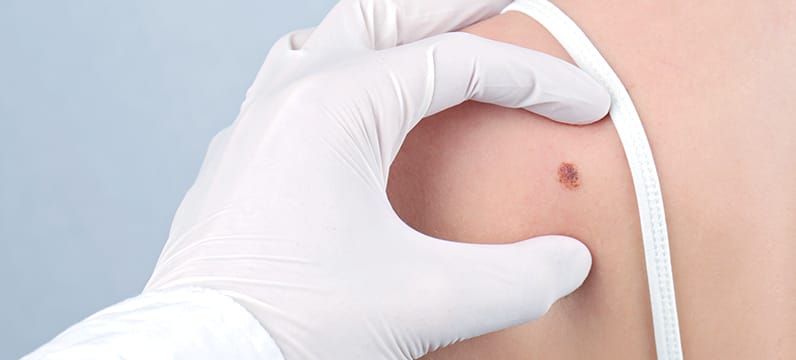Sun Damaged Skin Treatment &
Sun Spot Removal in South Miami

What is sun damage?
Spending time in the sun is inevitable and perfectly fine in small doses, but when you get too much sun exposure, it can lead to dark spots, wrinkles, and other signs of sun damage to your skin. The sun gives off ultraviolet light rays, also known as UV rays. This kind of light is what causes sunburn and long-term sun damage sometimes called sun spots or age spots.
What are the symptoms of sun-damaged skin?
The following common symptoms of sun damage may warrant a visit to our team of dermatologists at the Skin Center of South Miami:
What Is Photoaging?
Photoaging, also called photodamage or solar damage, describes the visible effect UV rays can have on your skin over time. When sunlight hits your skin, it causes a DNA change on the cellular level. This damage affects collagen and elastin fibers, which give your skin elasticity and help it to remodel, as well as epidermal cells, which serve as a skin barrier. Sun damage also weakens tiny blood vessels called capillaries, causing surface veins to appear.
If you’re concerned about photodamage, a high-SPF sunscreen is the best anti-aging skincare product on the market. Up to 90% of the visible skin changes we attribute to premature aging are caused by sun exposure. Common signs of photoaging include fine lines and wrinkles, texture changes, melasma, freckles, and actinic keratosis.
Actinic Keratosis and Sun Damage
Actinic keratosis, AKA solar keratosis, is a precancerous skin lesion that forms after chronic sun exposure. The patches are typically dry or scaly like sandpaper and can be pink, gray, brown, red, or tan. Actinic keratosis usually appears after age 40 in areas frequently exposed to the sun, like your face, hands, arms, scalp, ears, and legs. They may also burn, bleed, itch, or grow horn-like projections.
While actinic keratoses are extremely common, they’re not something you should ignore. About 10 percent of the lesions will develop into squamous cell carcinoma. Fortunately, the patches are very treatable.
A qualified dermatologist, like those at Skin Center of South Miami, can remove your actinic keratosis in a quick in-office appointment. A local anesthetic numbs the area while your dermatologist uses cryotherapy (freezing), scraping (curettage), photodynamic therapy, or laser therapy to remove the lesion.
How Much Does Sun Damage Increase Skin Cancer Risk?
Have you had five or more sunburns in your lifetime? You’re far from alone. While most of us would answer affirmatively, just a handful of sunburns can double your risk for melanoma. In fact, a single blistering sunburn in childhood or adolescence more than doubles your risk. The good news is that regular daily use of SPF 15+ sunscreen can reduce your risk of squamous cell carcinoma by 40 percent and melanoma by 50 percent.
You’re more likely to develop skin cancer if you have certain risk factors, including:
- Living in a sunny climate (like Florida).
- Having fair skin that burns easily, light hair, light eyes, and freckles.
- Working in an outdoor profession like landscaping, mail carrier, or garbage collector.
- Participating in outdoor sports or activities, especially aquatic sports.
What SPF Should I Use to Protect My Skin From Sun Damage?
The American Cancer Society recommends using a daily broad-spectrum sunscreen with an SPF of 30 or higher to protect against sun damage. UV damage can also occur through windows and on cloudy days, so layering on the SPF should always be part of your morning routine, regardless of the season.
Patients with darker or olive skin tones should still wear sunscreen daily, even if they don’t usually get sunburns. While skin cancer cases are lower in patients of color, they’re often diagnosed later, leading to lower survival rates. So whether you have pale, medium, or dark skin, you should wear sunscreen and book regular skin cancer screenings.
- Sunburn
- Scaly or peeling skin
- Dry or flaky skin
- Wrinkles
- Blisters
- Thickened skin
- Fine lines
- Patches of discolored skin
How can I prevent sun damage?
Some of the preventative measures you can take to avoid sun damage include:
- Wear protective clothing and sunscreen when outdoors
- Reapply sunscreen as directed on the bottle
- Stay in the shade when possible
- Limit the amount of time you spend in direct sunlight
- Drink plenty of water to avoid dry skin
- Use lotion regularly
Can I reverse sun damage?
Experts have proposed new ways to reverse some forms of sun damage; however, there is no way to entirely reverse skin problems caused by sun exposure. Some of the available treatment options that may be used to help improve the look of sun-damaged or aging skin include:
What Our Patients are Saying
“No sales pitch for products and services! A thorough body check for abnormal growths. In and out of the exam room in 15 minutes. Love Dr. Poochareon she is very personable and professional.” -E.G.
What are the benefits of visiting Skin Center of South Miami for sun spot removal?
The benefits of visiting an experienced dermatologist with the Skin Center of South Miami for sun spot treatment include the following:
- Non-invasive treatment options
- Improved look of lines, wrinkling, age spots, and other signs of sun damage
- Little or no discomfort during treatments
- Experienced physicians with specialization in treating sun damage
Call Skin Center of South Miami For Sun Damage Treatment!
If you are interested in reversing signs of sun damage, visit our experienced dermatologists at the Skin Center of South Miami. Our providers are experts at sun damage and age spot removal, early cancer detection, and treating sun-damaged skin. Our team is dedicated to delivering personalized dermatology care for every patient, no matter how big or small your concerns are. Call us at 305-740-6181 or fill out the form on this page to schedule a consultation today.
